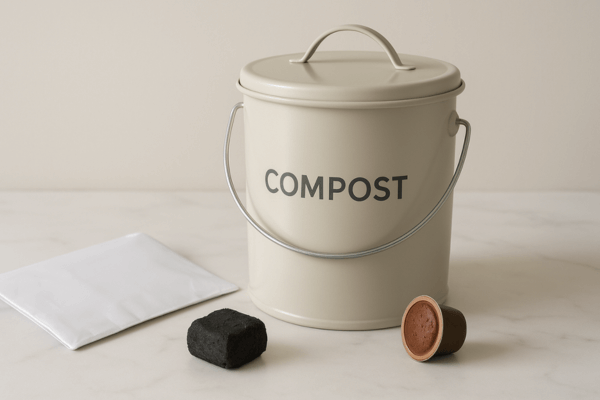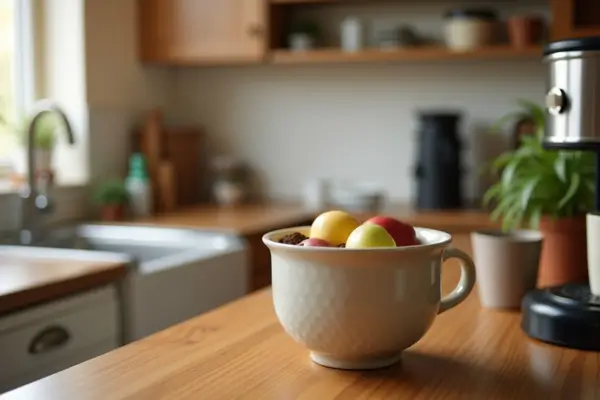Introduction: Why Your Small Bin Has Different Rules
So, you’ve decided to start composting! You’ve got your sleek countertop bin or your tidy balcony tumbler ready to go. You’re excited to turn your kitchen scraps into “black gold” and reduce your waste footprint. But let’s be honest—a little voice in the back of your head is whispering, “What about the smells? Will this attract fruit flies?”
Those are valid concerns, and here’s the secret: your small-space system isn’t just a miniature version of a giant backyard compost pile. It plays by a different set of rules.
In a large, outdoor heap, the sheer volume of material can generate intense heat—enough to break down tougher, smellier items like meat bones and rapidly kill off pathogens and weed seeds. Your compact system, whether it’s a worm bin, a bokashi bucket, or a small tumbler, is a cooler, more delicate ecosystem. It’s incredibly efficient, but it’s also more sensitive to what you feed it.
The good news? Keeping your system happy is simple. It all comes down to knowing what not to add. By following this straightforward “No” list, you can confidently avoid the common pitfalls. Say goodbye to worries about nasty odors, uninvited pests, and a sludgy, stagnant bin.
Consider this your ultimate beginner’s cheat sheet to a thriving, odor-free, and productive small-space compost system. Let’s dive in

Section 1: The Absolute “No” List – Avoid at All Costs
Think of this list as the non-negotiable rules for small-space composting. These items are the most common culprits behind failed compost projects, and for good reason. In a confined system, they can quickly lead to a stinky, pest-ridden mess that’s more trouble than it’s worth.
Why these are bad: Simply put, these materials attract pests, create foul odors, and can introduce diseases or toxins that a small, cool compost system simply cannot break down safely.
Here are the offenders to ban from your bin for good:
- Meat, Fish, and Bones: This is public enemy number one. These items rot very slowly and produce a profoundly foul, putrid smell as they decompose. They are a top-tier magnet for rats, raccoons, and swarms of flies. Just don’t do it.
- Dairy Products (cheese, milk, yogurt): Like meat, dairy decomposes slowly and anaerobically (without oxygen), creating strong, rancid odors. A piece of forgotten cheese or a splash of milk can sour your entire bin and attract every pest in the neighborhood.
- Fats, Grease, and Oils: These substances are trouble because they coat other compost materials, creating a waterproof barrier that chokes out the essential air and water flow your decomposers need to live. This leads to a slimy, anaerobic environment and, you guessed it, attracts unwanted critters.
- Pet Waste (dog/cat feces, cat litter): While manure from herbivores like rabbits is great for compost, waste from carnivorous pets like dogs and cats is not. It can contain harmful parasites (like roundworm, toxoplasmosis) and pathogens that are not reliably killed in a low-temperature compost system. Using this compost in a vegetable garden poses a serious health risk.
- Diseased or Pest-Ridden Plants: It might seem logical to compost a sick plant, but it’s a risky move. The disease spores or insect eggs can survive the composting process in a small bin. When you later use that compost, you could be reintroducing the problem right back into your garden soil, spreading the issue instead of solving it.
The Bottom Line: When it comes to these items, a strict “just say no” policy is the easiest way to ensure your composting journey is smooth and successful.

**Section 2: The “Use with Extreme Caution” List
Not everything in composting is a simple “yes” or “no.” This list is for the items that can be composted in theory, but require a bit of finesse. The golden rule here is moderation. In large quantities, these materials can easily disrupt the delicate balance of moisture, acidity, and pest-attraction in your small bin.
Think of these as “special occasion” ingredients, not everyday additions.
Here are the tricky offenders and how to handle them safely:
- Citrus Peels & Onions: While they are organic matter, their high acidity can be harmful to the beneficial worms in a worm bin and can slow down decomposition by making the overall environment too acidic.
- → Your Tip: Don’t add a whole lemon or onion at once. Use only very small, well-chopped amounts, and mix them thoroughly with other, less acidic scraps.
- Bread & Pasta: These starchy items mold very quickly, which isn’t inherently bad for decomposition, but that mold and the resulting smell are a powerful dinner bell for pests like ants and mice.
- → Your Tip: If you add them, do so in small quantities (e.g., a handful of crusts, not a whole loaf). Always bury them deeply in the center of the bin, covered by a layer of “browns” like shredded paper, to mask the scent.
- Cooked Foods (especially with sauces/oils): Plain, unsalted cooked vegetables are generally okay in small amounts. However, foods cooked with oils, butter, sauces, or high salt content are prone to the same issues as fats and dairy: odor and pests.
- → Your Tip: It’s best to avoid them altogether in a standard bin. The one exception is if you are using a Bokashi system, which ferments all food waste first, making it safe to then compost.
- Weeds with Mature Seeds: Adding a few young, seedless weeds is fine. But adding a weed that has gone to seed is asking for trouble. The seeds are incredibly resilient and may not be killed by the lower heat of a small bin.
- → Your Tip: Be vigilant! Check any weeds you pull. If they have mature, dry seed heads, it’s safer to toss them in the municipal green bin (if available) or dispose of them to avoid planting a weed problem all over your garden later.
The Bottom Line: When in doubt, leave it out. It’s better to have a slower, healthier compost system than to risk upsetting its balance with a questionable item.

**Section 3: The “Surprising But True” List – Common Misconceptions
This is where we separate composting fact from fiction. The items on this list are often mistaken for compostable material because they seem natural or plant-based. However, they contain hidden ingredients that can harm your compost’s ecosystem and, ultimately, your soil.
Why people get this wrong: It’s easy to assume that anything paper-like or derived from wood is a safe “brown” material for your bin. But modern manufacturing adds chemicals, plastics, and toxins that don’t belong in your organic cycle.
Let’s clear up the confusion:
- Glossy or Colored Paper (junk mail, magazines): That shiny, slick paper is coated with plastic polymers and often printed with inks that can contain heavy metals. These toxins don’t break down safely and will contaminate your precious compost.
- Stick to: Plain newspaper, cardboard (with tape removed), and non-glossy paper.
- Coal or Charcoal Ash: Ashes from a wood fire can be a great source of minerals in moderation. However, coal or commercial charcoal briquette ash is different. It can contain high concentrations of sulfur and other chemicals from the manufacturing process, which can harm your soil’s pH and poison your plants.
- When in doubt, leave it out.
- Non-Compostable Tea Bags & Coffee Pods: This is a sneaky one! Many modern tea bags are made with plastic mesh or are sealed with polypropylene plastic so they don’t disintegrate in hot water. Similarly, most single-use coffee pods are plastic. Composting them introduces microplastics into your soil.
- → Your Tip: Get in the habit of ripping open the tea bag to compost only the leaves. Look for brands that explicitly state they use plastic-free, compostable bags. For coffee pods, check the manufacturer’s details—unless they are specifically certified compostable, assume they contain plastic.
- Sawdust from Treated Wood: Sawdust from plain, untreated wood can be a fantastic carbon-rich “brown.” But sawdust from pressure-treated wood (often used for decks), painted wood, or stained wood is toxic. This wood is treated with chemicals like arsenic, copper, and chromium to resist rot and insects—substances you do not want leaching into your vegetable garden.
- Only use sawdust you are 100% sure comes from clean, untreated lumber.
The Bottom Line: Being a savvy composter means looking beyond the surface. When you’re unsure about an item, a quick check online or a simple rule of thumb—”if it’s processed or man-made, be skeptical”—will keep your compost pure and powerful.

Section 4: Your Quick-Reference Cheat Sheet
Bookmark this page, take a screenshot, or print this section! This at-a-glance table summarizes everything you need to know to keep your small-space compost system happy and healthy.
| Category | Do NOT Compost ❌ | Safe to Compost ✅ |
| Food Scraps | Meat, Fish, Bones, Dairy (cheese, milk), Oily & Greasy Foods | Fruit & Veggie Peels, Coffee Grounds & Filters, Tea Leaves (bag removed), Crushed Eggshells |
| Yard Waste | Diseased Plants, Weeds with Mature Seeds, Pesticide-Treated Clippings | Dry Leaves, Grass Clippings (in thin layers), Small Twigs, Fresh Weeds (no seeds) |
| Paper Products | Glossy/Colored Paper, Magazines, Stickers, Plastic-Coated Cardboard | Newspaper, Plain Cardboard (shredded), Paper Towels & Napkins (unused) |
| Other | Pet Waste, Fats/Grease/Oils, Coal Ash, Treated Wood Sawdust, | 100% Natural Fibers (cotton, wool), Wood Ash (from untreated wood in moderation), Houseplant Trimmings |
Pro-Tip for Success: Remember the balance! For every bucket of “greens” (food scraps), add a similar volume of “browns” (shredded paper, dry leaves) to keep your compost aerated and odor-free.
Of course! Here is the text for the blog’s conclusion, written to be encouraging and to drive reader engagement.
Conclusion: A Stink-Free Path to Black Gold
And there you have it! The secret to successful small-space composting isn’t about composting everything, but about composting the right things. By sticking to a simple, safe diet of fruit and veggie scraps, coffee grounds, and shredded paper or cardboard, you provide everything the microorganisms need without the common headaches.
Being a little picky with your scraps isn’t being difficult—it’s being smart. This careful approach ensures your composting journey is not only successful and rewarding but also remarkably hassle-free. You’ll be rewarded with rich, nutrient-dense “black gold” for your plants, all from the comfort of your kitchen or balcony, without the fear of smells or pests.
- 📌 Pin it or Save it! This is one cheat sheet you’ll want to keep handy. Bookmark this page or pin the image below to Pinterest for easy reference next time you’re at the compost bin!
- 💬 Let’s Talk Trash! What was the most surprising item on the list for you? Do you have a pro-tip for other beginners? Share your thoughts, questions, and composting wins in the comments below!
- 🚀 Ready to start? Now that you know what to compost, make sure you have the right system. Check out our next guide: ‘Choosing the Best Small-Space Compost Bin’ to find your perfect match



